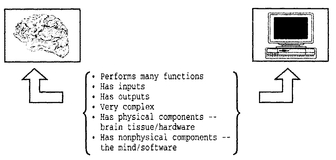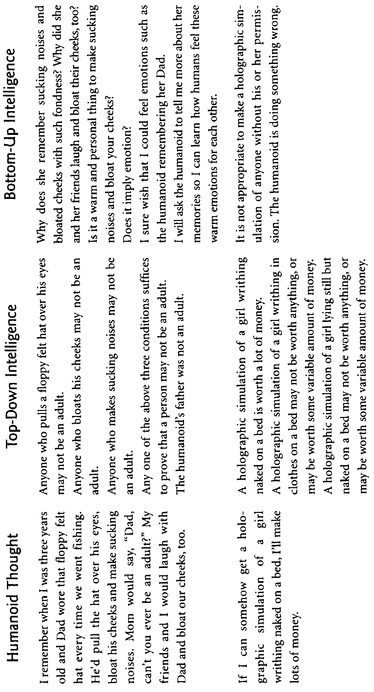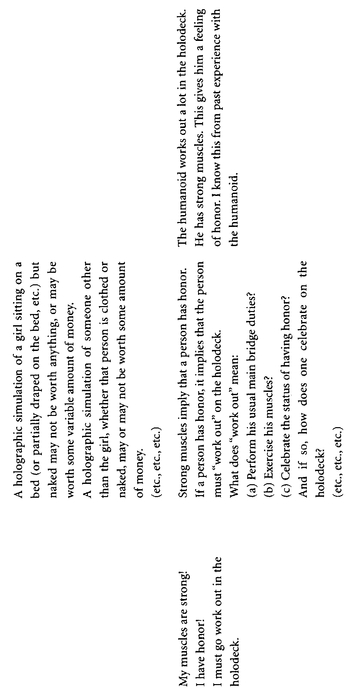The Computers of Star Trek (13 page)
Read The Computers of Star Trek Online
Authors: Lois H. Gresh
In the original series, the computers were all top-down machines. That was the generally accepted theory during the filming of the show. By the time of
The Next Generation,
bottom-up AI had become widely accepted. Thus the
Enterprise-D
computer seems much more capable than its predecessor. But perhaps not capable enough.
The Next Generation,
bottom-up AI had become widely accepted. Thus the
Enterprise-D
computer seems much more capable than its predecessor. But perhaps not capable enough.
A great deal of the
Star Trek
universe revolves around the concept of artificial intelligence. Without it, the computers of the twenty-fourth century wouldn't be that much different from what we have today. The ship's computer wouldn't be able to answer questions, replicators and transporters wouldn't work, and Data wouldn't be nearly as interesting. Nor would Johnny Fontaine be able to give Odo advice about women.
Star Trek
universe revolves around the concept of artificial intelligence. Without it, the computers of the twenty-fourth century wouldn't be that much different from what we have today. The ship's computer wouldn't be able to answer questions, replicators and transporters wouldn't work, and Data wouldn't be nearly as interesting. Nor would Johnny Fontaine be able to give Odo advice about women.
Let's take a more specific look at the similarities and differences between the human brain and the computer. This will give us a basis for analyzing Data, the holosuites and holodecks, Professor Moriarty, and other facets of bottom-up AI in
Star Trek.
Star Trek.
First the similarities:


The brain and the computer have some obvious things in common. The brain simultaneously daydreams, calculates overdue invoices that customers haven't paid, wonders if it's in love, wonders when the lunch guest will finally arrive at the office or whether the guest is lost, worries about Mom, and so forth. The computer simultaneously prints a chapter of this book, saves the chapter in case the power blows, downloads a file from the Internet, calculates overdue invoices that customers haven't paid, and so forth.
Similar, and yet different. The brain daydreams, creates, and worries; the computer does none of those things.
The brain accepts inputs from the eyes, skin, and blood. The computer accepts inputs from the keyboard, voice instructions, and data feeds. The brain issues output to the eyes, skin, and blood; the computer to the screen, networking cables, data feeds.
Both are very complex. Both have components of hardware and software, though of different materials and composition. But although we can build a working computer, we can't build a human brain. Despite their similarities the two are very different.
The basic circuitry in computers relies on the TRUE-FALSE, ON-OFF popping of micro-switches. Neurons in our brain also have TRUE-FALSE, ON-OFF states: excited and inhibited. When the voltage across a membrane rises sharply, the neuron is excited and releases chemicals (neurotransmitters) that latch onto receptors of other neurons. When the voltage drops sharply, the neuron is inhibited. Seems awfully similar to the binary ON-OFF states of the digital computer, doesn't it?
But if we look more closely at neural processes, we see a huge difference. Neurons actually behave in an analog rather than a digital manner.
k
Events leading to neural excitement build up, as
if climbing a hillâthis is a feature of analog signals. In addition, ions may cross the cell membrane even if neurotransmitters aren't received, and these ions may excite the neuron anyway. Sometimes, a neuron oscillates between intense and minor excitement levels without any outside stimulation. The more a neuron excites itself, the more prone it will be to outside stimulation.
k
Events leading to neural excitement build up, as
if climbing a hillâthis is a feature of analog signals. In addition, ions may cross the cell membrane even if neurotransmitters aren't received, and these ions may excite the neuron anyway. Sometimes, a neuron oscillates between intense and minor excitement levels without any outside stimulation. The more a neuron excites itself, the more prone it will be to outside stimulation.
In a computer, the shape of the motherboardâlarge rectangle, small rectangle, oblong, oval (we've never seen an oblong or oval motherboard, but it's an interesting concept)âhas no effect on how the computer functions. Positioning components close together, shortening circuit travel, and the choice of the actual components: these conditions certainly affect the processing speed and power of the computer. However, most motherboards are rectangles, and the actual shape really doesn't have some radical influence, such as popping an ON to OFF or making a NOR into an XOR.
The neuron, however, is quite different. There are approximately fifty neuron shapes that can change the state of the neuron from excited to inhibited, or vice-versa. For example, an incoming signal becomes weaker as it traverses a really long dendrite to the neuron body. A signal that travels along a short dendrite will be much more powerful when it hits the neuron body. In addition, it takes a higher dose of neurotransmitter to excite a fat neuron than to excite a small one.
Also, the brain uses a finite set of neurons to perform a flexible number of tasks in parallel. Neurons may interact in overlapping, multiple networks within the brain; a single neuron simultaneously communicates with many others in many neural networks. And by intercommunicating constantly across these multiple networks, neurons learn to adapt and respond to their environments. We liken the brain to a muscle: the more you use it, the stronger it becomes.
The more you do trigonometry problems, for example, the better you'll be at them twenty years from now.
l
l
How do we build such properties into a computer?
The ultimate result of bottom-up AI is what we think of as “alife,” literally artificial life. In this type of computer intelligence, digital organisms (entities, nodes, or units) not only adapt to their environment but reproduce, feed, and compete for resources. Their offspring evolve naturally over generations to become increasingly suited to their environments. Remember the nanite episode (“Evolution”) of
The Next Generation
, in which microscopic computer creatures infiltrated the ship? It isn't really that farfetched. Such digital creatures exist today in prototype form.
The Next Generation
, in which microscopic computer creatures infiltrated the ship? It isn't really that farfetched. Such digital creatures exist today in prototype form.
Some alife creatures use genetic algorithms that affect their life expectancy. The creatures have genomes to define what they're like, how they act, what they do. To reproduce, alife creatures cross-breed, and sometimes, as with biological life, the genomes are accidentally mutated, creating a next digital generation that is quite different from its parents.
m
m
Some alife creatures grow through what might be thought of as digital embryonics. Such a creature exists in silicon, which is divided
into cellsâwhere a row and column intersect as on a sheet of graph paper. Each cell contains a genome that's defined in random access memory. At the beginning of its life, the creature is the only individual in the silicon environment. This organism has a certain number of cells, just as we do at birth. Each cell has a special function, though the creature can have many cells that do the same thing. (For example, we have many skin cells and many nerve cells.) Which genes of the digital organism's cell will be functional depends on a cell's row and columnâits locationâin the creature.
into cellsâwhere a row and column intersect as on a sheet of graph paper. Each cell contains a genome that's defined in random access memory. At the beginning of its life, the creature is the only individual in the silicon environment. This organism has a certain number of cells, just as we do at birth. Each cell has a special function, though the creature can have many cells that do the same thing. (For example, we have many skin cells and many nerve cells.) Which genes of the digital organism's cell will be functional depends on a cell's row and columnâits locationâin the creature.
When the alife world begins, only one cell contains the entire genome of the organism. The first cell divides, just as it would in a biological embryo. Now there are two digital cells that each contain the entire genome of the organism. Soon, the entire digital creature exists, born digitally in a manner based on biology. By combining digital embryonics with evolutionary algorithms, we have the potential to grow truly complex, novel alife environments.
Aside from Wesley Crusher's experiment that swamped the
Enterprise
with nanites (“Evolution,” TNG),
Star Trek
features only a few alife creatures. For example, the exocomp servomechanisms on planet Tyrus VIIA, which Data protects at risk to his own life when he realizes that they have achieved self-awareness, were created by an evolutionary process (“The Quality of Life,”
TNG
). But
Star Trek
characters such as Data and Lea Brahms clearly are not alife. For example, they don't possess such features as cellular division and reproduction. They did not evolve.
Enterprise
with nanites (“Evolution,” TNG),
Star Trek
features only a few alife creatures. For example, the exocomp servomechanisms on planet Tyrus VIIA, which Data protects at risk to his own life when he realizes that they have achieved self-awareness, were created by an evolutionary process (“The Quality of Life,”
TNG
). But
Star Trek
characters such as Data and Lea Brahms clearly are not alife. For example, they don't possess such features as cellular division and reproduction. They did not evolve.
More common than alife is the simple form of AI built into today's robots. Back in 1969, a robot named Shakey was able to move around seven rooms that contained obstacles made of varying geometric shapes. Shakey received commandsâsuch as
“Bring me a box”âfrom a computer console. Then he
n
rode around on his little wheels, scooted past the obstacles, snaked through the rooms, scooped up a box, and returned it to some central location.
“Bring me a box”âfrom a computer console. Then he
n
rode around on his little wheels, scooted past the obstacles, snaked through the rooms, scooped up a box, and returned it to some central location.
The authors dream about going to MIT to play with the robots. We've read of insect robots, and even more cool, robots that wander around the laboratories and annoy people. Just reading about these robots makes us drool. Herbert the robot is extremely Borglike. He steals stuff from the office of the MIT professors. He has twenty-four microprocessors, thirty infrared sensors, a hand to pick stuff up, an arm, and an astonishing optical system. Then there's the six-legged giant insect called Genghis, propelled by twelve motors, maneuvering around the halls using twelve force sensors, six heat sensors, and two sensory whiskers(!). At MIT and other universities, there are many other Borglike robots wandering around already. Research is underway to construct robots with dual arms, plus speech and hearing skills. This is an intensely exciting part of modern life. We'll return to some of these issues, and others (such as vision in an android) in the chapter dealing with Data.
For now, let's return to the issue of artificial intelligence. Let's have some fun. We'll consider several idle thoughts and how a top-down AI would react compared to a bottom-up AI (see
Table 5.1
).
Table 5.1
).
As you can see, logic doesn't necessarily produce correct answers. People infer things, and we make mistakes. Logic yields
conclusions based on premises that we assume are true. However, if the premises are false, then the conclusions are false. Data's sometimes distressing dealings with human behavior clearly show that linear logic isn't always correct. Mr. Spock discovered the same truth years before Data.
conclusions based on premises that we assume are true. However, if the premises are false, then the conclusions are false. Data's sometimes distressing dealings with human behavior clearly show that linear logic isn't always correct. Mr. Spock discovered the same truth years before Data.
Perhaps the most astonishing artificially intelligent creatures in the
Star Trek
universe are the living holograms. Dr. Moriarty (“Elementary, Dear Data,” “Ship in a Bottle,”
TNG
) is the result of the ship's computer trying to come up with a villain smarter than Data. Though he never achieves independence from the holodeck, Moriarty still appears to have achieved sentience. Even more interesting are the inhabitants of Yadera II, an entire village consisting of holographic images so sophisticated that they think themselves normal beings (“Shadowplay,”
DS9
). Odo and Dax repair the holographic generator on the planet so that life can continue without interruption.
Star Trek
universe are the living holograms. Dr. Moriarty (“Elementary, Dear Data,” “Ship in a Bottle,”
TNG
) is the result of the ship's computer trying to come up with a villain smarter than Data. Though he never achieves independence from the holodeck, Moriarty still appears to have achieved sentience. Even more interesting are the inhabitants of Yadera II, an entire village consisting of holographic images so sophisticated that they think themselves normal beings (“Shadowplay,”
DS9
). Odo and Dax repair the holographic generator on the planet so that life can continue without interruption.
There's no question that AI exists in the
Trek
future. Yet in some ways the AI of 300 years from now seems extremely primitive. Why doesn't the computer on the
Enterprise
talk directly to the crew? Why does anyone need to tap a communicator badge? When Captain Picard is on the holodeck and a message arrives for him from Starfleet command, why doesn't the computer tell him directly about the transmission? When Geordi or Rom needs to repair some damage inside a Jeffries tube, why doesn't the computer give him instructions (much as Spock tells Dr. McCoy how to reconnect his brain in the classic adventure (“Spock's Brain,”
TOS
)? Better still, why doesn't the computer simply make the repairs itself? When the Kazon attack
Voyager,
why doesn't the ship's computer, filled with ten thousand attack scenarios, give Captain Janeway some advice on what to do?
Trek
future. Yet in some ways the AI of 300 years from now seems extremely primitive. Why doesn't the computer on the
Enterprise
talk directly to the crew? Why does anyone need to tap a communicator badge? When Captain Picard is on the holodeck and a message arrives for him from Starfleet command, why doesn't the computer tell him directly about the transmission? When Geordi or Rom needs to repair some damage inside a Jeffries tube, why doesn't the computer give him instructions (much as Spock tells Dr. McCoy how to reconnect his brain in the classic adventure (“Spock's Brain,”
TOS
)? Better still, why doesn't the computer simply make the repairs itself? When the Kazon attack
Voyager,
why doesn't the ship's computer, filled with ten thousand attack scenarios, give Captain Janeway some advice on what to do?


Other books
Tuck's Wrath by Jenika Snow
Gentlemen of the Road by Michael Chabon
The Gospel of Sheba by Lyndsay Faye
Look After You by Matthews, Elena
Mapuche by Caryl Ferey, Steven Randall
Book of My Mother by Albert Cohen
The Safe-Keeper's Secret by Sharon Shinn
The Secrets of Dr. Taverner by Dion Fortune
EG02 - The Lost Gardens by Anthony Eglin
Seducing the Laird by Marrero, Lauren